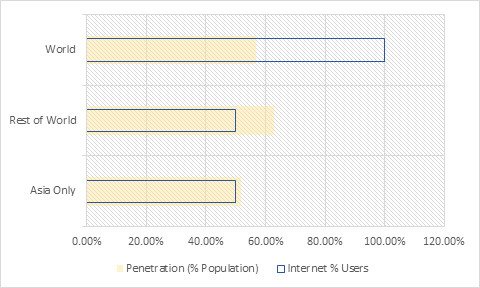
The digital age poses both challenges and opportunities for many developing countries in Asia and the Pacific. In recent years, we have seen jobs in various sectors become obsolete. At the same time, we see new economic spaces being created demanding new skills and competencies. This also necessitates finding innovative ways to facilitate learning and to promote knowledge sharing, especially in the context of economic development.
E-learning, or digital learning, is not a recent concept, with distance learning and open universities having been offered since the 1970s as alternative forms of education. These are, in a way, similar– both digital and distance learning facilitate not just synchronous but asynchronous learning (Kaplan and Haenlein 2016). With advancements in information and communication technologies (ICTs), various kinds of distance learning have been explored. Using various technologies, such as video streaming and web conferencing, both formal and non-formal e-learning has gained traction in recent years with academic institutions, training institutes, and international organizations. Especially for development organizations where resources are limited and development concerns many, e-learning and massively open online courses create opportunities to maximize development impacts, facilitate knowledge sharing, and build capacities in developing countries.
Defining e-learning is not as easy as it sounds. On the one hand, some define it as strictly being accessible using technological tools that are either web-based, web-distributed, or web-capable; on the other hand, some define it as including videotape, satellite broadcasts, and interactive TV (Moore et al. 2010). While intranets, CD-ROMs, and other mobile storage devices are still in use, with some forms of mobile storage becoming obsolete, we see e-learning increasingly becoming web-based. Further, we see variations in e-learning, with some being time-bound and others not.
Nevertheless, what clearly separates e-learning from traditional forms of education is that it allows learners to have spatial flexibility, similar to instructors who do not have to be in the same space as their learners. Further, e-learning courses, including those that offer complete degrees, are more affordable, with the bulk of the development costs usually incurred when the courses as well as the platforms are created. Finally, e-learning, which can be rapidly distributed and shared, lends itself scalability, in that it becomes easy to update.
For Asia, with more than 50% ICT penetration and internet usage in 2019, there is potential in e-learning for building capacities across the region. Governments in Asia are also increasingly moving toward e-governance, which implies better communication infrastructure and enhanced connectivity being already available. Governments should take advantage of this connectivity and investigate the potential of e-learning.
Figure 1: Internet Penetration in Asia, 2019

Source: Internet World Stats: Usage and Population Statistics https://www.internetworldstats.com/stats3.htm
There are several challenges, however; while internet penetration is high, there remains a substantial proportion of the region’s population that is not connected. Investment in communication infrastructure to improve connectivity is necessary in preparing for the changes of the digital age. Unequal access to ICT can create inequalities and deepen them where they already exist.
Apart from that, it is also important to understand what skills and competencies need to be developed. Digital skills need to be incorporated not only in basic education systems but also in technical and vocational education and training, tertiary levels of education, and lifelong learning programs (Lyons et al. 2019). For many, one barrier to exploring e-learning as an alternative method, especially for nonformal education, is the lack of prerequisite digital skills. An unaddressed digital skills divide can exacerbate inequalities and unemployment.
Visit the new ADBI E-Learning platform.
_____
References:
Internet World Stats. 2019. Internet Usage in Asia.
Kaplan, A. M. and M. Haenlein. 2016. Higher Education and the Digital Revolution: About MOOCs, SPOCs, Social Media, and the Cookie Monster. Business Horizons 59: 441—450.
Lyons, A. C., A. Zucchetti, J. Kass-Hanna, and C. Cobo. 2019. Bridging the Gap Between Digital Skills and Employability for Vulnerable Populations. Think 20 Policy Briefs.
Moore, J. L., C. Dickson-Deane, and K. Galyen. 2010. E-Learning, Online Learning, and Distance Learning Environments: Are They the Same? Internet and Higher Education 14: 129–135.








This is an important issue which has the strongest power to spread knowledge provided such e-learning methods are widely publicized, developed in English and Local Languages, Last but not the least it should precise, to the point, well articulated, attractive presentation with pictures and videos incorporated, and brief -each lesson should be limited to 30 minutes to one hour. If necessary each topic may be broken into small small lessons.
From my experience, I can say I did write e-learning materials mainly for sub-saharan African countries on Time Use Statistics and Contribution of women in GDP. Later on I made a mock TV show presentation at Kampala organised by Economic Commission of Africa. I am happy to see that many African countries are doing TUS.
This was possible because of involvement of concerned Statistical Offices of Sub Saharan African, NGOs and UN and other International organisations. Thus NSOs, NGOs and UN and other International organisations should be tied up in such endeavour. While developing SAARCSTAT portal (www.saarcstat.org) I had included many training materials not in e-learning modules. I experience says, development of training material in e-learning module is essential. World Bank developed Virtual Statistical System which I find very popular and effective. But initially it got resistance in PARIS21 meeting where I was a member. But ultimately, it succeeded.